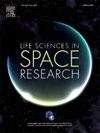Characterization of virulence-related phenotypes of Candida parapsilosis and Rhodotorula mucilaginosa isolated from the International Space Station (ISS)
IF 2.8
3区 生物学
Q2 ASTRONOMY & ASTROPHYSICS
引用次数: 0
Abstract
There is increased interest in characterizing and describing the effects of space stressors on human microflora. This study describes virulence-related phenotypes of two human yeast commensals, Rhodotorula mucilaginosa and Candida parapsilosis, isolated from the International Space Station (ISS). The strains were compared with ATCC control strains to provide insights into adaptation and phenotypic switching of fungal species in spacecraft environments. Strains were grown in media that induce filamentation and capsule production. Antimycotic susceptibility was determined after exposure of liquid cultures to fluconazole, amphotericin B, and caspofungin. Biofilm formation was quantified using the crystal violet assay, and autoinducer (AI) production was detected by activation of a reporter fluorescent gene present in biosensor bacterial strains. In vivo infection studies were conducted using a C. elegans killing model. Results indicated increased filamentation production patterns in ISS Candida parapsilosis and increased capsule production in ISS Rhodotorula. Additionally, there was increased resistance to antifungal activity, biofilm formation, long-chain autoinducer production, and heightened nematode virulence detected in the ISS isolates. These results suggest that space conditions might enhance adaptation and phenotypic plasticity in yeast, leading to increased virulence-related phenotypes.
国际空间站分离的假丝酵母菌和粘胶红酵母毒力相关表型的研究
人们对表征和描述空间压力源对人类微生物群的影响越来越感兴趣。本研究描述了从国际空间站(ISS)分离的两种人类酵母菌共生菌,粘液红酵母(Rhodotorula mucilaginosa)和假丝酵母(Candida parapsilosis)的毒力相关表型。将这些菌株与ATCC对照菌株进行比较,以深入了解真菌物种在航天器环境中的适应和表型转换。菌株在诱导成丝和蒴果形成的培养基中生长。液体培养物暴露于氟康唑、两性霉素B和卡泊芬菌素后测定抗真菌敏感性。使用结晶紫法定量生物膜的形成,并通过激活生物传感器菌株中的报告荧光基因来检测自诱导剂(AI)的产生。使用秀丽隐杆线虫杀伤模型进行体内感染研究。结果表明,ISS假丝酵母(Candida parapsilosis)的丝生成模式增加,ISS红霉菌(Rhodotorula)的胶囊生成模式增加。此外,在ISS分离株中检测到抗真菌活性,生物膜形成,长链自诱导剂产生和增强的线虫毒力的抗性增强。这些结果表明,空间条件可能会增强酵母的适应性和表型可塑性,导致毒力相关表型增加。
本文章由计算机程序翻译,如有差异,请以英文原文为准。
求助全文
约1分钟内获得全文
求助全文
来源期刊

Life Sciences in Space Research
Agricultural and Biological Sciences-Agricultural and Biological Sciences (miscellaneous)
CiteScore
5.30
自引率
8.00%
发文量
69
期刊介绍:
Life Sciences in Space Research publishes high quality original research and review articles in areas previously covered by the Life Sciences section of COSPAR''s other society journal Advances in Space Research.
Life Sciences in Space Research features an editorial team of top scientists in the space radiation field and guarantees a fast turnaround time from submission to editorial decision.
 求助内容:
求助内容: 应助结果提醒方式:
应助结果提醒方式:


